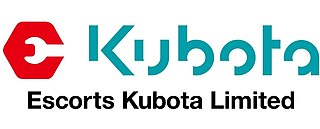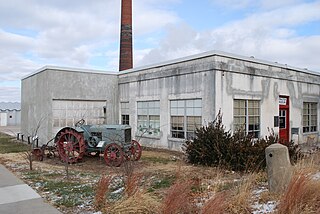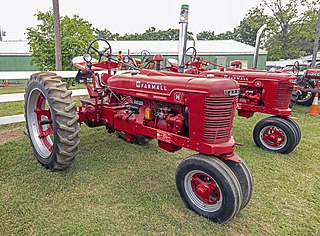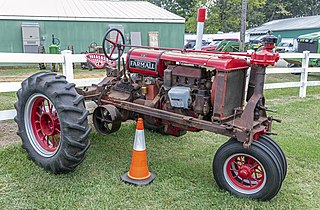Related Research Articles

A tractor is an engineering vehicle specifically designed to deliver a high tractive effort at slow speeds, for the purposes of hauling a trailer or machinery such as that used in agriculture, mining or construction. Most commonly, the term is used to describe a farm vehicle that provides the power and traction to mechanize agricultural tasks, especially tillage, and now many more. Agricultural implements may be towed behind or mounted on the tractor, and the tractor may also provide a source of power if the implement is mechanised.

Escorts Kubota Limited formerly Escorts Limited is an Indian multinational conglomerate that operates in the sectors of agricultural machinery, construction machinery, material handling, and railway equipment. Its headquarters are located in Faridabad, Haryana. The company was launched in 1944 and has marketing operations in more than 40 countries. Escorts manufactures tractors, automotive components, railway equipment, and construction and material handling equipment.

The Lester F. Larsen Tractor Test and Power Museum is a museum dedicated to preserving and documenting the history of Nebraska's tractor test law, operated by the University of Nebraska–Lincoln (NU) in Lincoln, Nebraska, United States. The Nebraska Tractor Test Law, passed in 1919 and administered by the university, requires performance testing on every tractor with forty horsepower or more sold in the state. The facility, initially established as the Nebraska Tractor Test Laboratory, was renamed for longtime chief engineer Lester F. Larsen when it was converted into a museum in 1998. It is the only tractor testing museum and the only complete tractor test laboratory in the world.

The Farmall Cub or International Cub was the smallest tractor manufactured by International Harvester (IH) under either the McCormick-Deering, Farmall, or International names from 1947 through 1979 in Louisville, Kentucky.

The John Deere Model A is a row crop tractor manufactured by Deere & Company. The A was produced in a wide variety of versions for special-purpose cultivation. It received a styling upgrade in 1939 and electric starting in 1947. With the advent of John Deere's numerical model numbering system, the A became the John Deere 60, and later the 620 and 630, 3010, 3020, 4030, 4040, 4050, 4055, and ended with the 7610.

Lincoln, Nebraska is the home of the state capitol of Nebraska, the University of Nebraska and has history dating back to the mid 1800s. A list of tourist attractions that can be found within the city are as follows.
Ford Tractor Company was a Minneapolis-based company active from 1916 to 1917, that built tractors to facilitate "horseless farming".

The Farmall H is a medium-sized two-plow row crop tractor produced by International Harvester under the Farmall brand from 1939 to 1954. It was the most widely produced of International Harvester's "letter series", with approximately 390,000 produced over the 14-year run. It succeeded the Farmall F-20. The H was incrementally updated with new model numbers as the Super H, 300, and 350, but remained essentially the same machine. The original H used an International Harvester C152 4-cylinder in-line engine. Production of all versions lasted until 1963.

The Farmall M is a large three-plow row crop tractor produced by International Harvester under the Farmall brand from 1939 to 1953. It was of International Harvester's "letter series". It succeeded the Farmall F-30. The M was incrementally updated with new model numbers as the Super M, Super M-TA, 400, and 450, but remained essentially the same machine. The original M used an International Harvester C248 4-cylinder in-line engine. Production of all versions lasted until 1954.

The Farmall C is a small two-plow row crop tractor produced by International Harvester under the Farmall brand from 1948 to 1951. The C was developed from the Farmall B as a slightly larger, more versatile implement, raising and moving the B's offset operator seat to the centerline and increasing the wheel size to allow a straight, widely-adjustable rear axle. The C kept the International Harvester C123 engine that had been used in the Super A model. The tractor was heavier and more robust, and featured hydraulic capability from the beginning. The C was incrementally updated with new model numbers as the Super C, 200, 230 and 240, but remained essentially the same machine. The closely related successors to the C were produced until 1962.

The Farmall A is a small one-plow row crop tractor produced by International Harvester under the Farmall brand from 1939 to 1947. The tractor was popular for its set of innovative features in a small, affordable implement. It succeeded the Farmall F-14. The A was incrementally updated with new model numbers as the Super A, 100, 130 and 140, but remained essentially the same machine. Like the smaller Farmall Cub, the Farmall A features a distinctive offset engine, displaced to the left over wide-set front wheels, to allow vision straight ahead. An International Harvester C113 4-cylinder in-line engine was used for early models, increased to an IH C123 with the A-1. The most significant change was the introduction of hydraulics with the Super A. The series was produced until 1973.

The McCormick-Deering W series tractors were a range of standard-tread farming and industrial tractors produced by International Harvester that were derived from the Farmall letter series row-crop tractors of the 1940s and 1950s. Branded by International Harvester as McCormick-Deering products, with the same styling and red paint as the Farmall line, the W series had fixed wheel widths, lower height and wide front axles. Starting in 1956 the W series was integrated into the International Harvester numbering series and the McCormick-Deering branding was dropped.

The Farmall F-30 is a large three-plow row crop tractor produced by International Harvester under the Farmall brand from 1931 to 1939, with approximately 28,900 produced. It was a larger successor to the Farmall Regular, and was replaced in 1939 by the Farmall M as the largest tractor in the Farmall line.

The Farmall F-20 is a medium-sized two-plow row crop tractor produced by International Harvester under the Farmall brand from 1932 to 1939, with approximately 148,000 produced. It replaced the Farmall Regular, and was itself replaced in 1939 by the Farmall H.

The Farmall Regular, or just the Farmall, was the first in the Farmall line of general-use row-crop tractors manufactured by International Harvester. The Regular was the first affordable tractor that could be used for plowing, stationary threshing, or cultivating. For most of its product life it was marketed as the "Farmall," with the "Regular" added when the Farmall F-20 and F-30 appeared as its successors. More than 134,000 were sold from 1924 to 1931.

The John Deere Model B tractor was a two-plow row-crop tractor produced by John Deere from 1935 to 1952, with direct successors produced until 1960. The B was a scaled-down, less expensive version of the John Deere Model A. It was followed by the updated 50, 520 and 530 models.

The John Deere Model G tractor was a large three-plow row-crop tractor produced by John Deere from 1937 to 1953, with successor models produced until 1961. It was followed by the 70, 720, and 730.

The John Deere Model M tractor was a two-cylinder row-crop tractor produced by John Deere from 1947 to 1952, with successor models produced until 1960. It was succeeded by the updated 40, 420 and 430 models, as well as the 320 and 330 models that occupied the market positions left vacant by the more powerful 400 series models.

The John Deere Model L tractor was a small one-plow row-crop tractor produced by John Deere from 1937 to 1946.

The John Deere Model R tractor was John Deere's first diesel tractor. A large, heavy tractor, it had fixed wheel widths and was not produced as a row-crop tractor with adjustable axles. The R was followed in the John Deere numbered model series by the John Deere 80, 820 and 830 tractors, which represented evolutionary upgrades to the basic R.
References
- ↑ Pripps, Robert N. (2020). The Field Guide to Classic Farm Tractors. Motorbooks. p. 7. ISBN 978-0-7603-6844-2.
- 1 2 "Tractor Testing in Nebraska". History Nebraska. Retrieved 29 August 2021.
- 1 2 3 4 Brown, Candace (October 5, 2015). "Nebraska Tractor Test". Antique Power. Erfel Publishing. Retrieved 29 August 2021.
- 1 2 "The Story of the Larsen Tractor Museum". Lester F. Larsen Tractor Test and Power Museum. University of Nebraska- Lincoln. Retrieved 29 August 2021.